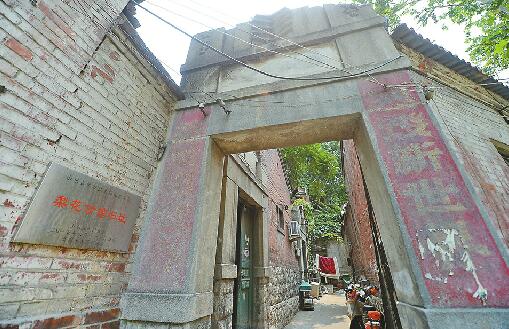Shun Network - Ji'nan times author:,
near the near future, the slanting road of the Shiqiao Street office is dismantling and dismantling, leaving the inclined Road North Head The pear Pavilion is again in the eyes of the people. It is known that it is one of the eight major public museums in Ji'nan history. It was found in the 2009 survey of cultural relics. It is one of the most well preserved architectural patterns, which has both historical and patriotic educational significance.

the tablet of the provincial cultural relic protection unit is suspended in front of the courtyard gate of the pear Pavilion. Reporter Wang Feng
Japanese spy Grottoes attract attention, there is a public trip to visit
3 afternoon, Ms. Zhang, the citizen riding electric car with her daughter to the road north of the site of the North pear Pavilion. This is the place where Japanese secret agents lived before, and spies were developed here. After parking, she encouraged her daughter to go into the lane along the memorial archway. Originally, I saw the media reports on the pear flower hall. Ms. Zhang took her daughter to see it on the spot. I hope it can make the children know more about the history of Japan invading China in this way, and it is also a field teaching. Ms. Zhang said.
Li Hua mansion is a LANIC building group consisting of 5 relatively independent courtyards and a corridor of 1 meters wide. The sign marks are 2, 4, 6, 8 and 10, respectively. The buildings are masonry structure. It is observed carefully that the bottom of the house is made of stones, about 1.2 meters high, and the upper part of the block is whole. The red brick, built on the base, can see the red tiles on the roof, and each courtyard is a wooden door.
Ms. Zhang, she walked along the Hutong, and soon came to the head. The doors of the 5 courtyards were closed. The wife of the Japanese spy, who lived here, was called the pear flower, and here it was named the pear flower house, where they were spying. Mrs. Zhang took her daughter's hand and bent slightly. She told her daughter about the history of the pear flower residence.
at present, there are 4 courtyards in the pear mansion. They are either tenants or newly moved households, and they claim not to know much about the Japanese spy Grottoes that once appeared during the war of resistance against Japan.
I moved here more than 30 years ago. The old lady next door knew something, but the old man had left early, and we just heard that there had been a Japanese spy before, and one of the 8 households in the slanting road said. At noon, Ms. Liu, who lived in hospital No. 6, the most innermost slanting road in the pear mansion, went home and listened to my father. We were occupied by the Germans and the Japanese before, and the Kuomintang was occupied by the Kuomintang during the war of liberation. After the founding of the new China, the yard was given to my father-in-law.
construction is well preserved. In 2015, the provincial civilian insurance unit was named
according to the historical records. The pear flower hall was established in 1941, 8 in the slanting Road, directly under the jurisdiction of the Shandong Japanese command headquarters, whose head is the old Japanese special agent Hayami Nobuhito, whose wife's name is pear flower, so it is called the pear flower hall. Before the
the Ji'nan Archaeological Institute, one of the staff in charge of the old building, introduced the historical relics survey in 2009, and found the site in comparison with historical materials and site visits. In 2015, it was declared as a provincial cultural relic protection unit. According to the analysis of the structure and style of the building, this building is similar to the local architectural form of the surrounding Ji'nan. It should be that the Japanese occupied the existing buildings as mansions. He said that during the war of resistance against Japan, the Japanese had eight public houses in Ji'nan, some rebuilt, some relocated, and some even did not exist. The former site of the pear pavilion was the perfect place for architectural style preservation, not only of research value but also a good base for patriotism education. It is understood that in the period of the invasion of China, Japan had more than 20 special service organizations in Ji'nan, among which the Phoenix Mansion, the public pavilion, the pear flower public hall, the Luren hall, the Lin Xiang public pavilion, the plum flower public hall, the cherry blossom public hall, the Luan mansion, and the appearance of the 8 Japanese special agents, which were called the eight big public houses.